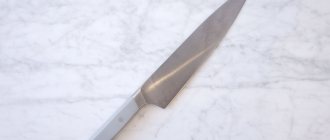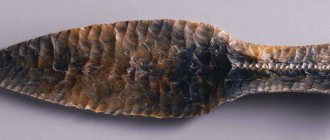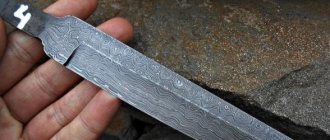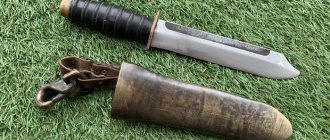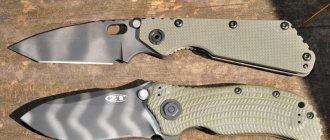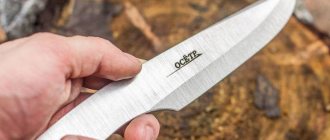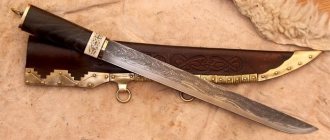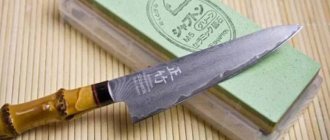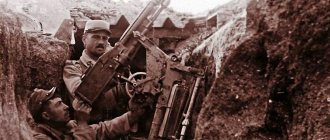Today we will talk about an interesting and necessary subject for every person. We use it every day, but sometimes we ourselves don’t know the history of its origin. And what he was like in very distant times. How did it come into human use? And that today not a single housewife, fisherman, hunter, traveler, etc. can do without it. Yes, to be honest, almost any person cannot do without it. Having intrigued the reader, now you can reveal the cards, this is a knife. Not everyone knows that he is not just a kitchen cutter, this is, if I may say so, a whole knife scientific direction.
Various types of knives.
Today, the types of knives are so diverse that there are more than 200 of them. And each type, accordingly, also has subspecies. I would like to say that there are so many of them today, and to describe all types of knives, it will take much more time and space than this one article. But we will try to talk about the most important and leading positions of this unique thing, the history of which begins with the “Stone Age”. And how did this subject get into our everyday life, but first things first.
History of the appearance and use of knives
The very history of the appearance of various types of knives begins with the Neanderthals. In the Stone Age, knives were made quite simply: they took large pieces of stones and broke them into pieces. Silicon or obsidian cobblestones were best suited for this “knife making procedure.” Due to their structure, they were broken into plates and the most suitable of them were used as a blade. But they were fragile, such a stone was rarely found and could not be sharpened. But if it split successfully, the cutter turned out to be very sharp and durable.
In the Bronze Age, people learned to use the bowels of the earth. And blades made of bronze and copper began to appear. Iron was also known at that time, but in terms of extraction and processing, it was much more difficult and expensive. For this reason, blades were made of copper and bronze. With the heyday of the Iron Age, blacksmithing began to develop. This century is considered the most bloody and this is, of course, connected with the development of blade production. All over the world and in all countries they learned how to make such products, and varieties of knives of all “suits” appeared. Further, the Renaissance contributed to the development of production and most knives today look like they were 1-2 centuries ago.
One of the first knives to appear.
They were used quite widely: from kitchen utensils to the most brutal murder weapon. But in fact, they are used every day by millions and billions of people for peaceful purposes. To prepare a simple regular breakfast, cutting bread, cheese or sausage, you will definitely need a knife. It doesn’t matter what blade you use to do this, a table blade, a folding blade, or a hunting blade. But we definitely can’t do without it.
Classification by purpose
Each knife is unique in its own way. But today their production has been established on an industrial scale. And to distinguish one product from another, a special classification of knives was introduced. The variety of blades is so great that it is simply impossible to do without systematizing their purpose, otherwise there will simply be confusion. There are five main classifications of knives. You need to understand that grouping them by purpose implies the area in which the blade is used. The fact is that if you take a kitchen knife, it will have more than a dozen subspecies. For example: chef's, bread, cutting, sirloin, cheese, etc. Let's try to understand this diversity.
Combat knives
To fulfill its tasks, the blade must be of very high strength. In films on the silver screen, we often see how sentries are “removed” with a combat knife. Its main task is to strike the enemy in close combat. Its main difference is a clearly marked guard; as a rule, they are made with a fixed blade. It has specific differences:
- oval handle;
- total length from 22 to 32 cm;
- one-and-a-half or two-sided sharpening;
- ease of removal from the sheath;
- treatment of the blade with dark coatings to eliminate shine in the dark.
Yes, indeed, such a blade can hit an enemy in battle, but practice shows that in fact, the blade is used much more often to perform other tasks. With the help of a tactical knife, you can remove any obstacles to the equipment of the shooting station, cut off tree branches and other obstacles. You can also use it for digging.
Austrian combat knife.
During a combat landing, when the lines become tangled, they are cut with a combat knife. Recently, plastic handcuffs have been used; they are good for cutting with wire cutters, but if the blade is equipped with a wave sharpening, then it will cope with this task. A combat weapon, it can work well under water; in real conditions, landing troops can “take it anywhere.” And if a fighter finds himself in a body of water, there is a high probability of getting entangled in fishing nets or bushes; a combat knife will again come to the rescue with these problems.
Knives for tourism
Hiking is partly an extreme activity. Unforeseen situations may occur, an attack by wild animals, or you yourself will go hunting for food. The blade must be a real versatile “assistant”. Touring knives must have many qualities for any situation. They are always made with a fixed blade. This gives it toughness. They can cut tree branches, ropes and other things. To open any canned goods, the sharpening angle of the blade tip should not be sharp.
Knife for a tourist.
The handle is made massive and durable for use as a cleaver. The blade must be wide to cope with such loads. It is better to choose a stainless steel blade. It is better if it is soft; such qualities will allow you to sharpen the blade on a hike. Recently, preference has been given to blades with plastic handles, there is no explanation for this. But, apparently, they are more convenient to use.
Knives for hunters
We must not forget that it may become the last chance if there is a fight with a wild animal. Such cases are rare, but it doesn’t happen to anyone. Hunting knives are a fairly extensive group of products. They find their application respectively in hunting. But such a blade can also be used at home, for cutting up carcasses or slaughtering livestock. And a truly hunting knife must have the right characteristics:
- the handle is made of wood only;
- the guard is not very large;
- preference is given to Damascus steel;
- the butt is thick 3-4 mm, the blade is 10-15 cm long, the hardness should definitely be higher than 58 HRC.
Knife for the hunter.
Also, the blade should lie comfortably in the hand, and the handle may have anatomical characteristics. Not everyone can skillfully wield such a hunting weapon. Among real hunters, knives are common, the handle of which is made of bone or animal horn; they are also often covered with various decorative paintings and inscriptions. And it is believed that the shorter the length of a hunter’s blade, the more professional he is. And he is a master in cutting up animal carcasses.
Kitchen
For cooking, kitchen types of knives are used, the names of which come from the functions they perform. They can be found in any kitchen. There is no need to keep a set of 10-15 items in the kitchen. To fulfill all the main purposes, three knives of different types will be enough. But they must be made of good steel and sharpened enough. This is what these “three heroes” should look like:
- The most important one, and it can be called a chef’s knife, must have a blade height of at least 20 cm, and the knife itself is a long knife, about 25-30 cm. Its main purpose is to cut and butcher meat, but it can also be used for slicing vegetables and fruits.
- The next assistant with which you can easily peel vegetables and fruits, and with the tip of the blade quickly remove minor imperfections in the fruit. It should not be long and wide, but with a sharp tip.
- This blade, of a rather peculiar shape, is a saw knife. With this tool it is quite easy to cut bread, the slices will be thin and the bread will not crumble.
This, one might say, is the minimum kit for a housewife in the kitchen. In fact, now you can find sets of 6 or even 10 items, or even more. This set will already include special knives for cutting cheese, pizza, butter, fruit or fillet, and so on. The handle of such products is usually made of plastic, but there are also all-metal ones. Advice to housewives: glass cutting boards are very popular now. But keep in mind that any blade quickly becomes dull on them. Use either a wooden or plastic board.
Kitchen knife.
Also, ceramic knives have recently become quite popular; the advantage, of course, is its long-lasting sharpness, but the disadvantage lies in its fragility and it is easy to break it. You won't be able to sharpen it at home. Conventional kitchen blades are made of carbon steel. They are quite durable, and sharpening it at home will not be a problem.
Special
There are quite a lot of their varieties. Special blades include products for narrow, specialized activities. These include: for needlework, folding, gardening, surgical tools, construction tools with replaceable blades, for rock climbing, shoe making, for diving, stationery, various trimmers, with a firing mechanism and edge trimmers. In general, this is a whole knife trend that requires a separate description, the article has a slightly different character, and this will be clear later.
Knife for needlework.
Saw - serator
Part of the blade blade can be sharpened in the form of a saw; it is intended for cutting fibrous materials. From the English word serrated, such a section of the blade is called serrated. On knives intended for self-defense, serrated sharpening makes cutting thick outer clothing easier.
Sometimes such sharpening is performed along the entire length of the blade. It may look different from different manufacturers. Such a blade is not easy to sharpen at home. To do this, you will need a special tool and it is better to contact a specialist.
Division by type of construction
The design type of the knife itself plays a significant role in the characteristics of the blade itself. Having a very long history, the blades gradually evolved and received some distinctive features in terms of the design itself. Today, there are three main design features of knives. Each of them is divided into smaller subtypes:
- The design is the most reliable, with a fixed blade. They are considered to be the most ancient blades and today they have the widest use. They come in three subspecies: regular, spliced and skeletal.
- Folding knives are also quite common, especially in the tourist area. It is very convenient to hide the blade in the handle. It takes up little space, but there are some minor drawbacks. If you press hard on it, there is a possibility of the blade folding. Nothing lasts forever, and the mechanism that holds the blade becomes loose. This type also comes in three subtypes: switchblade, handle folding to the side, and the so-called “butterfly”.
- Another subtype of design characteristics of knives, with a removable blade. This category basically includes construction tools. In fact, the blade is separated from the handle and attached temporarily. As soon as it fails or becomes dull, the blade is removed and discarded. Then it is replaced with the same one. But due to the thin spine of the blades themselves, their use is very limited. And to be honest, it’s very difficult to call these replaceable blades a blade. It's more of a construction tool, nothing more.
Different types of knives with different designs.
Main types of blade profiles
Today, knifemakers have achieved a great variety of shapes and varieties of blades. So many options have already been invented that it is sometimes difficult to determine which type of profile a particular blade belongs to. But if you look at the history of the blades themselves, you can clearly see that each nationality and nationality had its own preferences. If European craftsmen always strived for straight lines, then Eastern weapons had a more varied form. They were attracted by smooth curved blades, and sabers had curved shapes. But these actions can easily be justified; you can’t gut fish with a wide cleaver; you need another knife. Or he will clear a passage in the thickets, which is impossible with a kitchen knife. Therefore, all types of knives and their purposes have been built over the centuries based on the terrain and specific needs of use. Blade profiles considered basic:
- A blade with a straight spine is quite common. It can almost be called universal, as it copes well with any task. It cuts and stabs normally, and is often found on the kitchen shelf.
- Drop point, due to its design features, has greater impact efficiency. The top chip has a smooth surface. Or slightly convex. The tip is shifted relative to the line of the butt. It easily enters the attack element and comes out just as easily. The point of application of force coincides with the tip.
- Trailing point due to the raised point of the butt, the piercing properties are lost. The cutting ability of the knife is excellent.
- Clip point has a second name in honor of its creator, Colonel Bowie. There are many legends surrounding its origin, but its peculiarity is the upper bevel of the blade. This profile is very suitable for combat knives. It is a concave recess, due to which the point of impact is in the center of the blade.
- Scramasax is quite rare. But thanks to its unusual shape, it has good cutting properties. It is similar to a blade with a straight spine, but only in reverse. It's as if they were sharpened on the reverse side.
- The tanto knife was invented by the Japanese and modified by the Americans. Has two cutting surfaces. Often found in models of combat knives.
- Spear point is spear-shaped, cutting part on both sides. Refers to daggers and hunting blades. It is quite popular among projectiles.
- Spay point is used for skinning carcasses and belongs to the hunting family. A short blade, the upper bevel is not sharpened, to prevent damage to the skin of the animal being butchered.
- The Hawkbill blade is very good at cutting. The tip is below the center of the knife. In appearance it looks like the beak of a bird of prey. Not suitable for domestic use.
- Needle point has the shape of a classic stiletto, narrow, long, sharpened on both sides. It is intended only for stabbing strikes.
- Gut hook features a hook at the end of the blade. Very similar in shape to a drop point, ideal for gutting fish and cutting animal skins.
There are several more options for blade profiles, but experts consider them to be variations of those presented above. In addition to the blade profile, there are many other characteristics.
Different shapes of knife blades.
Cutting edges and bevels
The manufacture of a blade is based on such important parameters as the cutting edge and bevels. The functionality and convenience of the blade can be preliminarily assessed by these parameters. The goals pursued are quite important, and these indicators come in different types, the main ones being:
- pentagonal profile with a straight descent, has an obtuse cutting edge angle. Used in kitchen matters;
- straight wedge with leads to the cutting edge. It has a good cut and sufficient structural strength. The cutting edge angle is quite small, the descent is flat;
- blade with lens-shaped bevels, used in professional chef models. And in models of Japanese weapons;
- with concave bevels (razor bevel). The butt is quite durable and thick. Straight razors and some types of knives that require sharpness are sharpened in this way;
- pentagonal without leads, the cutting edge angle is very small and the descent is flat. They are comfortable and cut well. It is not recommended for them to chop;
- straight wedge from the butt, cutting and descent as in the previous type. The cutting edge can be adjusted even sharper and the weight of the blade is noticeably lighter;
- chisel profile, is used for working tools. Rarely, but can be found in Japanese cuisine.
There are other options for descents and RCs, the above mentioned can be called the main ones. Based on them, other varieties are made.
Geometry of the cutting edge of the knife.
Additional blade elements
The blade has quite a few different characteristics. We won’t talk about them in detail, but they definitely need to be voiced. For example, such an element as the edge of the blade, this is the place of the largest cross-section, or the butt is the blunt edge of the blade opposite the blade, also quite often called the “back of the blade.” Or, for example, the belly is a blade that does not have a straight part and is completely curved. This part is found in a hunting knife with a falling edge. The blade has fullers, head, blade width, blade width, bevel width, lead width and many other characteristics.
Handles
The second most important element of a knife is the handle. The handle is mounted to the blade in two ways. The first of them, called mounted, the handle is placed on the shank of the blade with an internal hole. And the second method is called plate - this is when the handle consists of two plates and they are attached to the shank on both sides, forming a handle. The two halves are fastened either with metal rings or rivets. The handle is the part of the handle that a person holds with his hand.
Religious significance
There is no direct connection between weapons and the religious component. However, it is noted that the Kathars became the favorite weapon of the Rajputs. A special caste (varna), an almost closed socio-religious group. Warriors of this class wore blades on the right. Often used in conjunction with a saber (like a dagger and sword among Europeans).
The Sikhs, or rather one of their branches, the Nihangs, preferred the katar as a “one-strike weapon.” These warriors, trained in a special way, professed the moral and theosophical principle of “chatkha”. By killing the enemy, the attacking beast, with one single blow, the nihang demonstrated that he did it without bitterness. Out of necessity.
Basic materials for production
The simplest version of the handle is a simple rope wrap. This option is suitable for knives made entirely of metal or tactical options. The main ones are those made of plastic, wood, horn and bone. For large-scale production production, as a rule, the first two options are used. There is a type of rubber called kraton. It is used as an insert or the entire handle is made entirely from it. Its rubberized properties allow you to hold the knife very well. Another unique material - fiberglass, having high dielectric qualities, moisture resistance and non-flammability, attracts many people.
And from more noble materials, such as horn or bone, craftsmen make one-piece pieces, at the request of the customer. They are decorated with carvings or precious stones and precious metals. Quite often the results are real works of art. In general, we can say that handles are made from quite a large number of materials, to suit every taste.
Leather blanks for knife handles.
Decorative finishing of the Cathars
Each product bears the mark of the master - fragments of finishing, special elements that emphasize the status of the owner. Precious metals were often used to process catarrhs in India. In addition to gold and silver, embossing and enamel painting were used.
Often gunsmiths worked using the koftgari technique. This is a traditional Indian way of finishing weapons with gold. Its essence lies in the mechanical introduction of a golden thread into the body of the jamadhar. After heat treatment and grinding, the metals formed a single whole.
